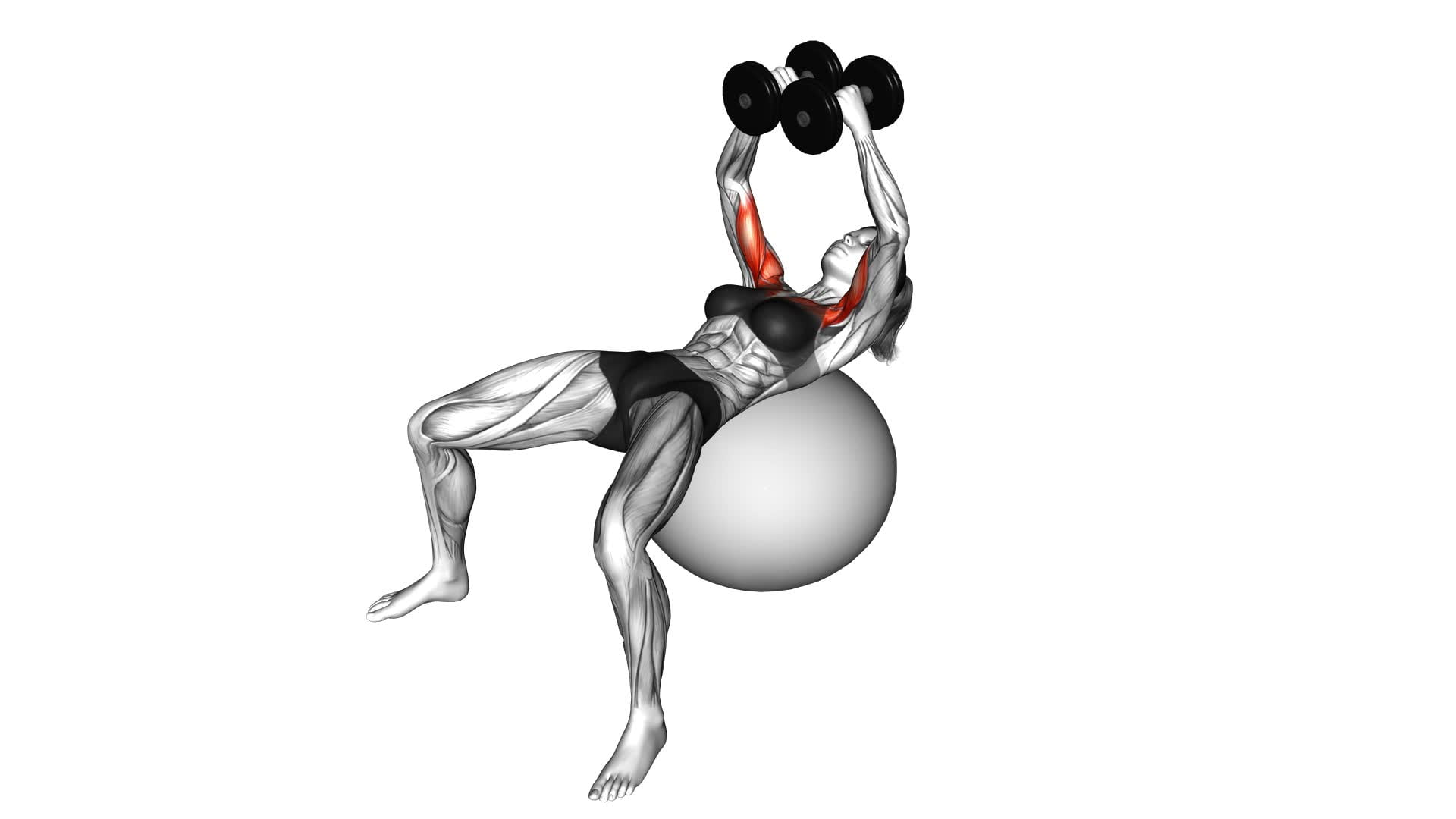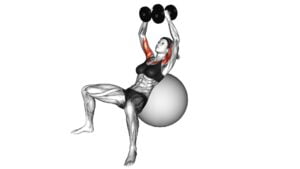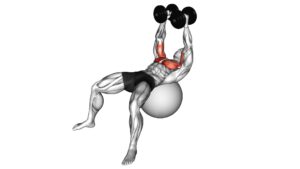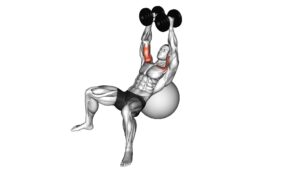Dumbbell Fly on Exercise Ball (female) – Video Exercise Guide & Tips

Are you a woman looking to enhance your upper body strength and tone your muscles? Then the dumbbell fly on an exercise ball is the perfect exercise for you.
Watch This Exercise Video
In this video exercise guide, we will show you the proper form and execution of this effective workout. Avoid common mistakes and maximize your results with our helpful tips.
Get ready to strengthen and sculpt your upper body with the dumbbell fly on an exercise ball.
Let's dive in!
Key Takeaways
- Dumbbell Fly on Exercise Ball improves upper body strength and targets chest, shoulders, and arms.
- Engaging core muscles for balance and stability is crucial during this exercise.
- The exercise builds and tones chest muscles over time and improves shoulder strength and stability.
- It is important to choose the right weight, engage core muscles, control the movement, and maintain good form for maximum results.
Benefits of the Dumbbell Fly on Exercise Ball
You can experience several benefits by incorporating the Dumbbell Fly on an Exercise Ball into your workout routine. This exercise is great for improving upper body strength and targeting the muscles in your chest, shoulders, and arms. The Dumbbell Fly on an Exercise Ball is a variation of the traditional dumbbell fly, which is typically performed on a flat bench. By performing this exercise on an exercise ball, you engage your core muscles to maintain balance and stability throughout the movement.
One of the key benefits of the Dumbbell Fly on an Exercise Ball is that it helps to strengthen your chest muscles. As you lower the dumbbells out to the sides, you stretch and activate the pectoral muscles. When you bring the dumbbells back up, you contract your chest muscles to return to the starting position. This repetitive motion helps to build and tone your chest muscles over time.
Additionally, the Dumbbell Fly on an Exercise Ball also targets your shoulder muscles. As you extend your arms out to the sides, you engage your deltoids, which are the muscles responsible for shoulder abduction. This exercise can help to improve your shoulder strength and stability, which can be beneficial for everyday activities and sports performance.
Incorporating variations of the dumbbell fly, such as the Dumbbell Fly on an Exercise Ball, into your workout routine can provide a fresh challenge and help to prevent plateauing. This exercise not only improves upper body strength, but also engages your core muscles for added stability. Give it a try and start reaping the benefits today.
Equipment and Setup for the Exercise
To properly perform the Dumbbell Fly on an Exercise Ball, you'll need the following equipment and setup. Firstly, you'll need an exercise ball that's the appropriate size for your height. Exercise balls come in different sizes, so make sure to choose one that allows your knees to form a 90-degree angle when sitting on it. As for the dumbbells, you can choose a weight that suits your fitness level and goals. Beginners may want to start with lighter weights, such as 5 or 8 pounds, while more advanced individuals can opt for heavier ones. Additionally, having a mat or a soft surface beneath the exercise ball can provide added stability and cushioning.
When it comes to modifications for beginners, there are a few options. If you find it challenging to maintain proper balance on the exercise ball, you can start by doing the Dumbbell Fly on a stable surface, such as a bench or the floor. Once you feel more comfortable, you can progress to performing the exercise on the exercise ball. Another modification is to use lighter dumbbells or even no weights at all. This will allow you to focus on mastering the movement and building strength gradually. Remember, it's important to listen to your body and choose the modifications that work best for you.
Proper Form and Execution of the Dumbbell Fly
To properly execute the Dumbbell Fly on an Exercise Ball, focus on maintaining proper form throughout the movement while engaging your chest and shoulder muscles. Here are some key points to keep in mind:
- Lie on the exercise ball with your head, neck, and upper back supported. Keep your feet flat on the floor for stability.
- Hold a dumbbell in each hand, with your arms extended straight up above your chest.
- Slowly lower your arms out to the sides in a wide arc, while maintaining a slight bend in your elbows. Keep your palms facing each other.
- Stop when your arms are parallel to the floor or slightly lower. Feel the stretch in your chest muscles.
- Engage your chest and shoulder muscles as you bring your arms back up to the starting position, exhaling as you go.
- Avoid these common mistakes: using weights that are too heavy, allowing your back to arch excessively, and rushing through the movement.
The benefits of the Dumbbell Fly on an Exercise Ball include strengthening your chest and shoulder muscles, improving upper body stability, and enhancing overall posture. By following proper form and executing the exercise correctly, you can maximize the effectiveness of the Dumbbell Fly and achieve your fitness goals.
Common Mistakes to Avoid
When performing the Dumbbell Fly on an Exercise Ball, it's important to be aware of common mistakes that can hinder your progress. To ensure you're getting the most out of this exercise, it's crucial to maintain proper technique.
One common mistake to avoid is using weights that are too heavy. While it may be tempting to go for the heavier dumbbells, using excessive weight can compromise your form and increase the risk of injury.
Another mistake is failing to engage your core muscles. Your core plays a key role in stabilizing your body during this exercise, so make sure to activate those muscles throughout the movement.
Additionally, avoid rounding your shoulders or hunching your back. This can put unnecessary strain on your neck and shoulders and take away from the effectiveness of the exercise.
Lastly, rushing through the reps is another common mistake. Take your time and focus on the quality of each repetition, rather than trying to complete them quickly.
Tips to Maximize Results With the Dumbbell Fly
To maximize results with the Dumbbell Fly on an Exercise Ball, focus on proper form and technique throughout the exercise. Here are some tips and techniques to help you get the most out of your workout:
- Start with the right weight: Choose dumbbells that challenge you but still allow you to maintain proper form. Aim for a weight that allows you to perform 8-12 reps with good control and without compromising your form.
- Engage your core: Throughout the exercise, make sure to engage your core muscles by pulling your belly button towards your spine. This will help stabilize your body and prevent any excessive movement or rocking on the exercise ball.
- Control the movement: When performing the dumbbell fly, focus on a slow and controlled movement. Lower the dumbbells out to the sides in a wide arc, feeling a stretch in your chest muscles. Then, squeeze your chest muscles as you bring the dumbbells back up to the starting position.
Frequently Asked Questions
How Many Sets and Repetitions Should I Do for the Dumbbell Fly on Exercise Ball?
To get the best results from the dumbbell fly on the exercise ball, it's important to know how many sets and repetitions to do.
By incorporating this exercise into your routine, you can target your chest and shoulder muscles while also engaging your core for stability.
To determine the right number of sets and reps, consider your fitness level and goals.
Start with 2-3 sets of 10-12 reps and gradually increase as you get stronger.
Can Men Also Perform the Dumbbell Fly on Exercise Ball?
Yes, men can also perform the dumbbell fly on an exercise ball. It isn't limited to women.
This exercise is a great way to target your chest muscles and improve upper body strength. Beginners should start with lighter weights to ensure proper form and avoid injury.
As you become more comfortable and stronger, you can gradually increase the weight. Remember to always listen to your body and consult with a professional if needed.
Is It Necessary to Use an Exercise Ball for This Exercise, or Can I Use a Bench Instead?
Is using an exercise ball more effective than using a bench for the dumbbell fly?
What're the benefits of using an exercise ball for the dumbbell fly?
It's important to consider whether using an exercise ball or a bench for the dumbbell fly is necessary.
The exercise ball adds an element of instability, engaging more muscles and improving core strength.
It also requires balance and coordination.
However, using a bench provides stability and allows for heavier weights.
Ultimately, it depends on your fitness goals and preferences.
What Are Some Alternative Exercises That Target the Same Muscle Groups as the Dumbbell Fly on Exercise Ball?
When looking for alternative exercises that target the same muscle groups as the dumbbell fly on an exercise ball, there are a few options you can consider.
Incorporating exercises like the dumbbell fly on a bench, cable fly, or chest press can help you work similar muscles. However, it's important to note that the exercise ball provides additional benefits like improved stability and core engagement.
How Often Should I Include the Dumbbell Fly on Exercise Ball in My Workout Routine to See Results?
To see results from the dumbbell fly on exercise ball, it's important to include it regularly in your workout routine. The frequency will depend on various factors like your fitness level and goals. Generally, aim for 2-3 sessions per week.
To maximize effectiveness, make sure you're performing the exercise properly. Maintain proper form, control the weights throughout the movement, and focus on engaging the targeted muscle groups.
Consistency and proper technique are key for seeing results.
Conclusion
In conclusion, the dumbbell fly on an exercise ball is a beneficial exercise that targets the chest muscles while also engaging the core for stability.
By using proper form and avoiding common mistakes, individuals can maximize their results and see improvements in their upper body strength and muscle tone.
Incorporating this exercise into a regular workout routine can help individuals achieve their fitness goals.

Author
Years ago, the spark of my life’s passion ignited in my mind the moment I stepped into the local gym for the first time. The inaugural bead of perspiration, the initial endeavor, the very first surge of endorphins, and a sense of pride that washed over me post-workout marked the beginning of my deep-seated interest in strength sports, fitness, and sports nutrition. This very curiosity blossomed rapidly into a profound fascination, propelling me to earn a Master’s degree in Physical Education from the Academy of Physical Education in Krakow, followed by a Sports Manager diploma from the Jagiellonian University. My journey of growth led me to gain more specialized qualifications, such as being a certified personal trainer with a focus on sports dietetics, a lifeguard, and an instructor for wellness and corrective gymnastics. Theoretical knowledge paired seamlessly with practical experience, reinforcing my belief that the transformation of individuals under my guidance was also a reflection of my personal growth. This belief holds true even today. Each day, I strive to push the boundaries and explore new realms. These realms gently elevate me to greater heights. The unique combination of passion for my field and the continuous quest for growth fuels my drive to break new ground.







